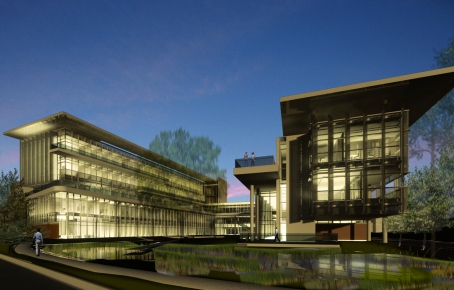By Czerne M. Reid
The University of Florida today will launch construction on its new Clinical and Translational Research Building, a new home for research that will speed scientific discoveries to patients. Set for completion in January 2013, the $45 million, 120,000-square-foot complex will spark collaboration and spur medical advances by bringing together research teams from a range of scientific disciplines.
“This marks the beginning of a new era in clinical and translational science research at UF,” said David Guzick, M.D., Ph.D., senior vice president for health affairs and president of the UF&Shands Health System. “The CTRB will be the home of patient-centered innovation and discoveries that help secure a healthy future for the citizens of Florida and the nation.”
The building will house the UF Institute on Aging, the Clinical and Translational Science Institute and an array of other research departments and clinical programs, as well as state-of-the-art conference, training and reception areas.
“One of our most important jobs as a major research institution is to streamline the process of getting medical discoveries from the lab to the hospital or doctor’s office,” said UF President Bernie Machen, D.D.S. M.S., Ph.D. “That’s just what this building is designed to do, and at the same time it will help further advance UF’s position as a national leader in research and in patient care.”
The almost 40,000-square-foot Institute on Aging complex is funded under the American Recovery and Reinvestment Act of 2009 through a $15 million grant from the NIH National Center for Research Resources. The adjoining 80,000-square-foot portion of the facility is funded by $30 million from UF. The project will create an estimated 175 new jobs and retain 670.
“This building illustrates our commitment to creating multi-functional research facilities that take advantage of the University of Florida’s cross-disciplinary strengths,” said Win Phillips, D.Sc., UF vice president for research. “State-of-the-art infrastructure is critical to the university’s research mission.”
The Institute on Aging will have a one-stop facility that will make it easier for mobility-restricted older adults to take part in clinical trials, and strengthen connections among existing UF research centers, including the Claude D. Pepper Older Americans Independence Center, the CTSI and the Cognitive Aging and Memory Clinical Translational Research Program. A geriatric medicine multispecialty clinic will also be in the new building.

“This is a unique and well-timed opportunity to have basic and clinical scientists and health services researchers working together as neighbors and partners toward improving the health and independence of older adults,” said Marco Pahor, M.D., director of the UF Institute on Aging.
The CTSI, which will be headquartered in the new building, serves as the hub of an expanding research network that connects all 16 UF colleges as well as Shands HealthCare and the North Florida/South Georgia Veterans Health System.
Also in the building are extensive new research and training facilities, including clinical research programs in diabetes and muscular dystrophy and departments such as health outcomes and policy, epidemiology, biostatistics and biomedical informatics.
“The new facilities will stimulate a transformation in how we conduct clinical research by dramatically increasing the venues and resources for patient-oriented research, training and community participation,” said David R. Nelson, M.D., director of the UF Clinical and Translational Science Institute. “We will be able to truly integrate the statewide resources of the UF research community.”
Designed to meet the highest sustainability standards aimed at conserving resources, reducing pollution and making indoor spaces conducive to good health and well-being, the new facility is poised to earn a Platinum Plus rating from the Leadership in Energy and Environmental Design, or LEED, program of the U.S. Green Building Council. The building incorporates features to improve indoor air quality through the use of low-emission building materials, efficient energy production and use through photovoltaic cells, and light sensor and water conservation technologies. The project also calls for prevention of construction activity pollution and reduction of light pollution from the completed building.
Architectural design, engineering, manufacturing and construction is being carried out by Perkins + Will, Moses and Associates, AEI, SEG, Siebein and Associates, Skanska, Brame Architects, Williams-Scotsman and Brentwood Company.
“We are continually working to strengthen the university’s commitment to sustainable design,” said Carol Walker, assistant vice president and director of UF’s facilities planning and construction division. “With the CTRB, we are aiming for the top.”
Related Media Coverage
- Gainesville Sun, May 16, 2012: UF hopes new building breaks down walls between researchers
- HOME magazine, Oct./Nov. 2011: UF Clinical and Translational Research Building broadens research opportunities
- Gainesville Sun, May 26, 2011: UF research center being built with non-state funds
- WCJB-TV ABC 20, May 26, 2011: Breaking ground on new UF research facility
- WUFT-FM, May 26, 2011: UF breaks ground on new health sciences facility


